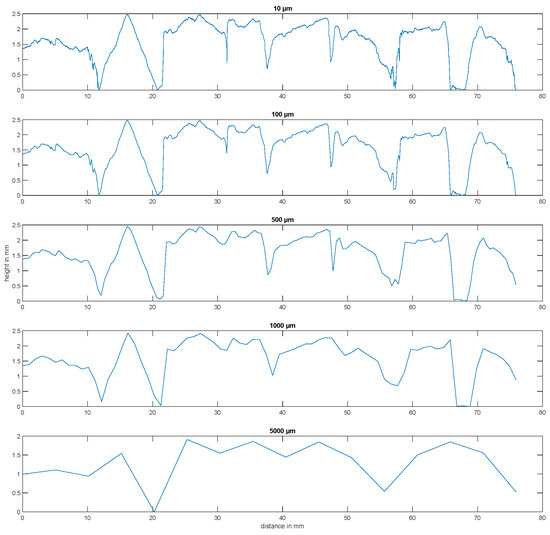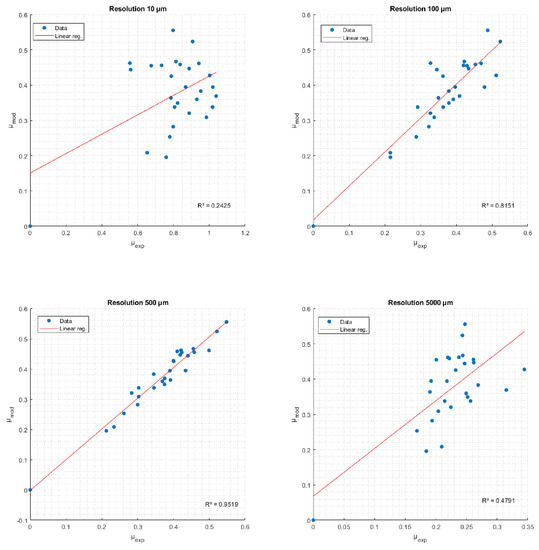Abstract
The objective of this work is to determine the appropriate resolution of pavement textures representative of their surface skid resistance. The friction and the texture of different pavement surfaces were first measured. Then, the friction of these pavements was computed using the dynamic friction model (DFM) and the resampled textures at different resolutions. Finally, a comparison of the experimental and model results is made possible to determine the optimal resolution, bringing them as close as possible. After analyzing the results, it was found that the optimal resolution is 500 µm in these study conditions.
1. Introduction
Pavement friction is one of the most important parameters for the safety of road users. Indeed, this pavement property allows vehicles to minimize their stopping distance and thus, minimize collision risks. The most important pavement parameter with respect to friction is its surface texture. Indeed, this texture, composed of several wavelengths generally classified in two groups (microtexture and macrotexture), and which allow, via its penetration of tire tread, to oppose the movement of the tire. However, to our knowledge and despite the definition of these two texture ranges, no study or expert has stated the resolution at which these surface textures should be captured [1,2,3,4,5,6].
And yet, defining this resolution would make it possible to completely dispense with actual measurements of tire–pavement friction. Which, instead of reporting the pavement contribution only, will also strongly depend on the tire, as well as the operating conditions of the contact [7]. The appropriate captured texture would allow the definition of the texture parameters correlating with pavement friction. It is obvious that the same texture parameter of the same surface will depend on the resolution with which the surface is captured. Hence, the need to define the appropriate resolution of pavement texture representative of its friction is obvious.
2. Approach
To explore the texture resolution effect, the friction and the texture of a set of pavement surfaces are first measured. Then, in a second step, from these measured textures, different new resolutions are created by resampling. The friction of these resampled textures is calculated using the dynamic friction model (DFM [8,9,10,11,12,13]), a model already validated. In a third step, a comparison between calculated friction (with the DFM) and the experimentally measured friction on the set of pavement surfaces are conducted in order to determine which of the resolutions (obtained after resampling) allows the most accurate prediction.
3. Dynamic Friction Model
The DFM or dynamic friction model is a friction model of a rubber pad/pavement based on the modeling of the contact of these two bodies [8,9,10,11,12,13]. This model considers the type of rubber, the roughness of the road, the level of wetting and the operating conditions (load, sliding speed, etc.). It has been validated several times and has thus shown its ability to predict the friction between a rubber pad and a pavement surface. This model has also not evolved since its development, as it is a fairly comprehensive representation of tire/pavement friction, considering the characteristics of the tire as its geometry, tread, slip rate, etc. For all calculations performed with the DFM, the contribution of wavelength scales is considered below the resolution as being µadh = 0.145. (This adhesion friction coefficient corresponds to the optimum value which, inputted to the DMF, outputs the best prediction of the experimental friction.) [8,9,10,11,12,13].
4. Raw Experimental Data
Thirty different surfaces were tested. These 30 surfaces were obtained from 5 different types of aggregates; for each of these aggregates, 1 asphalt and 1 mosaic sample were made [14]. Each of these samples underwent three levels of polishing using the polishing head of the Wehner–Schultz machine [14,15], which makes three states of roughness for each sample. So, in summary: 3 aggregates times 2 types of samples times 3 levels of polishing. Each of these 30 surfaces underwent friction measurement using the friction head of the WS machine.
Additionally, each texture of these 30 surfaces was captured at 10 µm resolution using a high resolute profilometer. Each original texture is composed of 15 parallel profiles, 76 mm long, spaced at 0.5 mm and sampled every 10 µm. The other 4 resolutions were generated from the original texture via resampling as follows. To achieve 100 µm resolution (and, respectively for 500 µm, 1000 µm, and 5000 µm), 1 in 10 points (50 points, 100 points, and 500 points, respectively) was retained from the original profile. So, in addition to the original resolution, 4 other resolutions of 100 µm, 500 µm, 1000 µm, and 5000 µm of each surface were obtained from the one at 10 µm (Figure 1).

Figure 1.
Example of an original profile and the 4 others resolution of that profile.
5. Results and Discussion
The selected surfaces and the polishing carried out on them allowed us to cover a wide range of friction ranging from 0.2 to 0.6. The figures below compare the experimental results with the computational results from the DFM. The curves in Figure 2 show the correlation lines between measured and calculated friction for the five resolutions. For each resolution, the R² was evaluated. Figure 3 shows the variation of R2 as a function of resolution.

Figure 2.
Comparison between the experimental results and the computational results from the DFM at the five resolutions (only four are displayed here).

Figure 3.
Variation of R2 as a function of resolution.
When analyzing these curves, we can conclude that the representative resolution of the texture, in relation to the pavement friction, is 500 µm. This is a bit surprising, considering all the efforts made to implement technologies capable of capturing road surfaces in higher resolutions. Any texture parameter to be computed in the future to report on this pavement characteristic must then be computed from a texture captured at this resolution.
6. Conclusions
The objective of this work was to determine the appropriate resolution of pavement textures representative of their frictions. A set of pavement surfaces have been selected and their frictions and textures have been measured. Then, from these measured textures at different resolutions, the friction of each surface was computed using the DFM. The comparison between the experimental results and model allowed us to conclude that the appropriate resolution is 500 µm. However, it has been noted that the sliding speed in question in this study was 60 km/h and that optimal resolution could not be the same at other speeds.
Author Contributions
Conceptualization, M.K.; methodology, M.K.; software, M.K.; validation, M.K. and M.-T.D.; formal analysis, M.K.; investigation, M.K.; writing—review and editing, M.K. and M.-T.D.; visualization, M.K.; supervision, M.K. All authors have read and agreed to the published version of the manuscript.
Funding
This research received no external funding.
Institutional Review Board Statement
Not applicable.
Informed Consent Statement
Not applicable.
Data Availability Statement
The data presented are openly available at: Mendeley Data, V1, doi: 10.17632/kkcztnxzph.1 (https://data.mendeley.com/datasets/kkcztnxzph/1).
Conflicts of Interest
The authors declare no conflict of interest.
References
- Beautru, Y.; Kane, M.; Do, M.-T.; Cerezo, V. Influence of road surface microtexture on thin water film traction. In Proceedings of the 7th International Conference on Maintenance and Rehabilitation of Pavements and Technological Control, MAIREPAV 2012, Auckland, New Zealand, 28–30 August 2012. [Google Scholar]
- Kane, M. A contribution of the analysis of the road macrotexture and microtexture roles vis-à-vis skid resistance. J. Test. Eval. 2022, 50, 20210047. [Google Scholar] [CrossRef]
- Kane, M.; Edmondson, V. Skid resistance: Understanding the role of road texture scales using a signal decomposition technique and a friction model. Int. J. Pavement Eng. 2022, 23, 499–513. [Google Scholar] [CrossRef]
- Kane, M.; Rado, Z.; Timmons, A. Exploring the texture-friction relationship: From texture empirical decomposition to pavement friction. Int. J. Pavement Eng. 2015, 16, 919–928. [Google Scholar] [CrossRef]
- Do, M.-T.; Cerezo, V.; Beautru, Y.; Kane, M. Modeling of the connection road surface microtexture/water depth/friction. Wear 2013, 302, 1426–1435. [Google Scholar] [CrossRef]
- Edmondson, V.; Woodward, J.; Lim, M.; Kane, M.; Martin, J.; Shyha, I. Improved non-contact 3D field and processing techniques to achieve macrotexture characterisation of pavements. Constr. Build. Mater. 2019, 227, 116693. [Google Scholar] [CrossRef]
- Rasol, M.; Schmidt, F.; Ientile, S.; Adelaide, L.; Nedjar, B.; Kane, M.; Chevalier, C. Progress and monitoring opportunities of skid resistance in road transport: A critical review and road sensors. Remote Sens. 2021, 13, 3729. [Google Scholar] [CrossRef]
- Kane, M.; Artamendi, I.; Scarpas, T. Long-term skid resistance of asphalt surfacings: Correlation between Wehner-Schulze friction values and the mineralogical composition of the aggregates. Wear 2013, 303, 235–243. [Google Scholar] [CrossRef]
- Kane, M.; Cerezo, V. A contribution to tyre/road friction modeling: From a simplified dynamic frictional contact model to a “Dynamic Friction Tester” model. Wear 2015, 342–343, 163–171. [Google Scholar] [CrossRef]
- Kane, M.; Do, M.-T.; Cerezo, V.; Rado, Z.; Khelifi, C. Contribution to pavement friction modelling: An introduction of the wetting effect. Int. J. Pavement Eng. 2019, 20, 965–976. [Google Scholar] [CrossRef]
- Kane, M.; Edmondson, V. Tyre/road friction prediction: Introduction a simplified numerical tool based on contact modelling. Veh. Syst. Dyn. 2022, 60, 770–789. [Google Scholar] [CrossRef]
- Edmondson, V.; Ardill, O.; Martin, J.; Lim, M.; Kane, M.; Woodward, J. Quantifying long-term rates of texture change on road networks. Int. J. Pavement Eng. 2022, 23, 1957–1969. [Google Scholar] [CrossRef]
- Kane, M.; Lim, M.; Tan Do, M.; Edmonsond, V. A new predictive skid resistance model (PSRM) for pavement evolution due to texture polishing by traffic. Constr. Build. Mater. 2022, 342, 128052. [Google Scholar] [CrossRef]
- Kane, M. Road polishing: High-resolution textures dataset of three mosaics made of different aggregates at different polishing stages. Data Brief 2022, 45, 108594. [Google Scholar] [CrossRef] [PubMed]
- Do, M.-T.; Tang, Z.; Kane, M.; de Larrard, F. Pavement polishing-Development of a dedicated laboratory test and its correlation with road results. Wear 2007, 263, 36–42. [Google Scholar] [CrossRef]
Disclaimer/Publisher’s Note: The statements, opinions and data contained in all publications are solely those of the individual author(s) and contributor(s) and not of MDPI and/or the editor(s). MDPI and/or the editor(s) disclaim responsibility for any injury to people or property resulting from any ideas, methods, instructions or products referred to in the content. |
© 2023 by the authors. Licensee MDPI, Basel, Switzerland. This article is an open access article distributed under the terms and conditions of the Creative Commons Attribution (CC BY) license (https://creativecommons.org/licenses/by/4.0/).